Chrysler’s Stock Car Connection — Part 9
BACK TO RACING: Chrysler continues its winning ways going into the Spring of ’66 as NASCAR plays loose with the rules.
By Wm. R. LaDow Photos from “Conversations with a Winner—The Ray Nichels Story.”
THE STORY SO FAR
Part 1- Aug. 2013: GM bows out of NASCAR, opening the door for F.R. Householder, Chrysler’s Manager—Circuit High Performance Competition, to sign on Nichels’ Engineering, which formerly fielded race-winning Pontiacs, to become Chrysler’s stock car builder. Part 2- Oct. 2013: Nichels debuts his 1963 Plymouths. Initial testing and competition prove out Nichels designs. USAC drops a bomb. Part 3- Dec. 2013: The Hemi debuts and sends shockwaves through the racing world. Part 4- Feb 2014: The Daytona Firecracker 400, NASCAR’s bombshell and the end of an era. Part 5- April 2014: NASCAR bans the Hemi. Part 6- June 2014: Nichels keeps Chrysler in the game by running other circuits as NASCAR tires to lure Chrysler back. Part 7- Aug. 2014: 1966–Chrysler and NASCAR settle their differences, and Ray Nichels expands his operation with a new factory and new drivers. Part8- Oct. 2014: Chrysler unveils the new Dodge Charger, surprises with the 405-cube Hemi and gets hit with exploding tires.
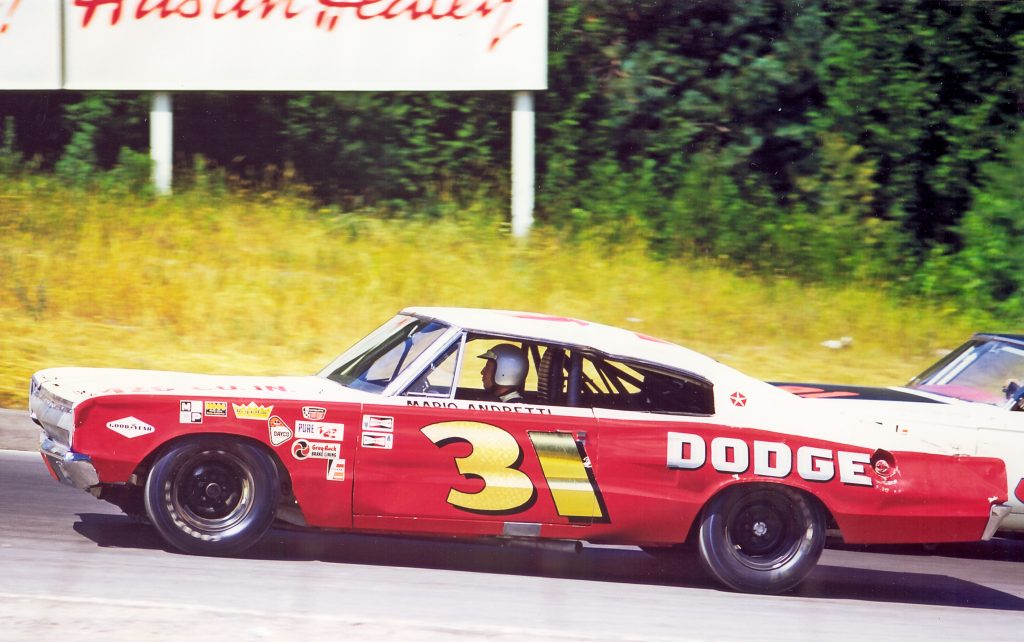
Back To Racing
It was now April 17th, 1966 and Nichels Engineering was racing at two different tracks, located in two different parts of the country. After qualifying sixth and eleventh respectively, McQuagg and Goldsmith gave their best effort in the 250 miler on the paved North Wilkesboro Speedway in North Carolina. The 400 lap battle took its toll on the equipment though, with McQuagg losing an engine and finishing 17th. Goldsmith had an even rougher day losing his brakes and finishing 24th. Chrysler still took the top three spots with Jim Paschal scoring the first ever victory for his patron, Tom Friedkin in a Nichels Engineering-built Plymouth.
Meanwhile up north, Norm Nelson raced to his first USAC victory of the year in the 150 miler at Langhorne. Jim Hurtubise finished second, Sal Tovella copped third, while Don White in his Nichels Engineering Dodge Charger finished fourth. Chrysler drivers took seven of the top 10 spots.
Virginia 500
A week later, on the NASCAR circuit, the 11th Annual
Virginia 500 held at Martinsville Speedway provided its fans with a racing
story of a lifetime. For Nichels Engineering’s driver Paul Goldsmith, the
outcome of the race offered both good news and bad news. The good news was when
Goldy crossed the finish line he captured the checkered flag and spent the next
45 minutes celebrating in Victory Circle with his Nichels Engineering crew.
Paul then learned the bad news. NASCAR officials had lost track of Paul’s No.
99 Nichels Plymouth during one of his pit stops and incorrectly scored
Goldsmith with an extra lap. Jim Paschal, with his Friedkin Plymouth sitting
just behind Goldsmith’s in Victory Circle, was informed (as he had contended
since the end of the race) that he had rightfully earned his second consecutive
NASCAR victory. Goldsmith was more than gracious when he learned he was not the
race winner and publicly lauded Paschal for his race winning effort. Overall,
Nichels Engineering and Chrysler did quite well on the day with McQuagg
finishing 16th and Mopars making up seven of the top ten spots. It was clear
that the Mopar machines were now dominating more than ever with the Ford
Factory support gone. However, a look at the race results showed some Ford
drivers boycotting their own boycott and driving whatever raceworthy race cars
they could find. Many Ford drivers began to publicly question Ford’s decision
to boycott and it was clear there was unrest in the Ford driving ranks.
Goldsmith then headed to the Richmond 250, held on the half-mile dirt track at
the Atlantic Rural Fairgrounds in Richmond, Virginia. The 125 mile race on May
15th saw Paul start 12th and finish fifth, with David Pearson, in his Cotton
Owens Dodge, getting his fifth victory in just 19 races. The David
Pearson-Cotton Owens team was on a roll.
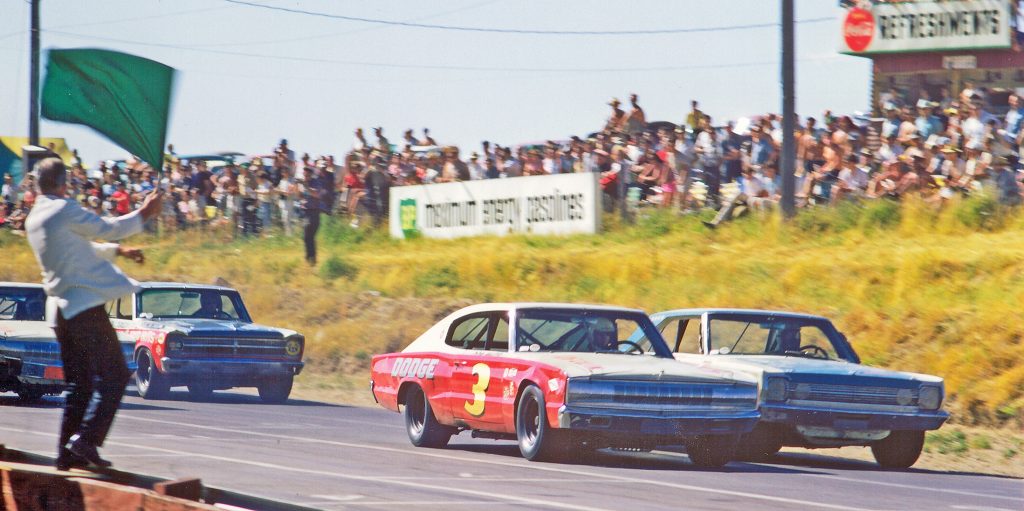
NASCAR gets weird
The longest race of the year for the Nichels Engineering racing effort was, the World 600 at the Charlotte Motor Speedway on May 22nd. Goldsmith and McQuagg were joined by Don White for one of NASCAR’s biggest stock car races of the year. Things got interesting early on, as several teams timing Goldy during his early practice laps were stunned by his speeds. The lean, quiet, West Virginia-born Nichels driver was absolutely scorching the high-banked Charlotte track. Word began to surface that Chrysler engineers and Nichels crew members had re-worked the front end of the No. 99 Nichels Engineering Hemi-powered Plymouth Belvedere. It was soon learned that through a process of dropping the nose and subtly altering the shape of the bumper, hood and fenders, Nichels Engineering had created a much more aerodynamic racecar. Once the word got out and Goldsmith’s recorded speeds proved to be so far above the norm, NASCAR Chief Inspector Norris Friel (an old friend of Ray Nichels from their days racing Indy cars on the old AAA sanctioned Championship Trail) called Nichels aside and asked that he and Goldsmith hold off on qualifying until NASCAR could appraise the impact of their new found aerodynamic advantage. Ray and Paul reluctantly agreed and watched Richard Petty take the pole with a speed of 148.637 mph, a substantially slower mark than Goldsmith‘s pre-race runs.
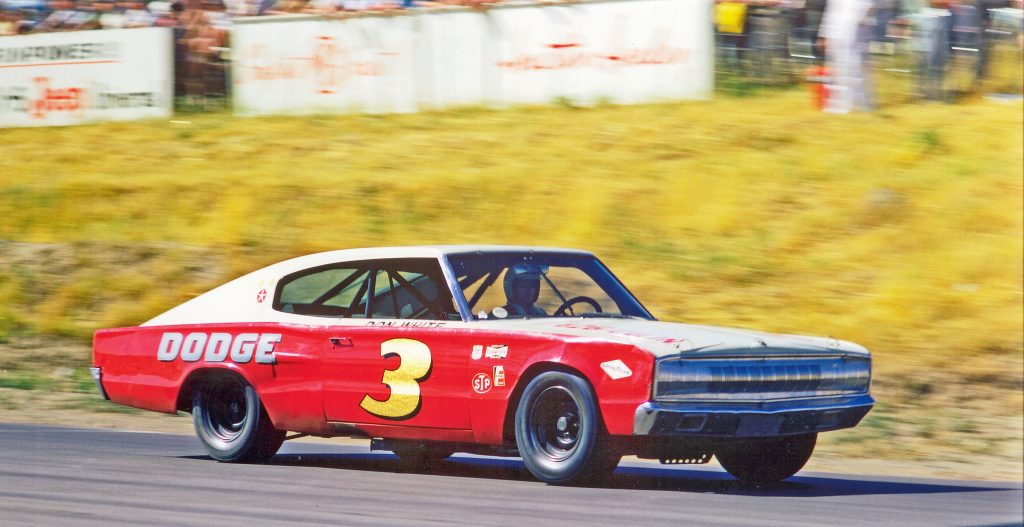
Goldsmith wasn’t the only Nichels chauffeur to be challenged by the NASCAR inspection process. Don White began to realize that NASCAR inspectors seemed to spend considerably more time inspecting the USAC star’s Dodge than other NASCAR driver’s cars. In time, White would come to realize, that even though NASCAR race fans welcomed him and other USAC drivers like A.J. Foyt, Norm Nelson, and Jim Hurtubise, the NASCAR inspectors were not as generous with their acceptance. The USAC drivers were not part of the NASCAR “good old boy” network and it showed at times during the inspection process. On many occasions, White would find himself being told his car did not meet NASCAR standards and would be sent back to the garages to “correct” the problem, robbing Don of important practice time. More than once White would find himself qualifying at the end of the line and battling his way into the field. What surprised White and others the most was the fact the Sam McQuagg’s Nichels Engineering Dodge Charger was setup identically to White’s, but McQuagg never seemed to run into the time consuming inspection difficulties that Don White and other USAC drivers did. This was of particular importance to Ray Nichels who (as the “house” builder for all of Chrysler) insisted his team always be above board due to his concern that if Nichels cars were consistently found to be out of compliance, it would create a NASCAR inspection process where all of the Chrysler teams would be under increased scrutiny.
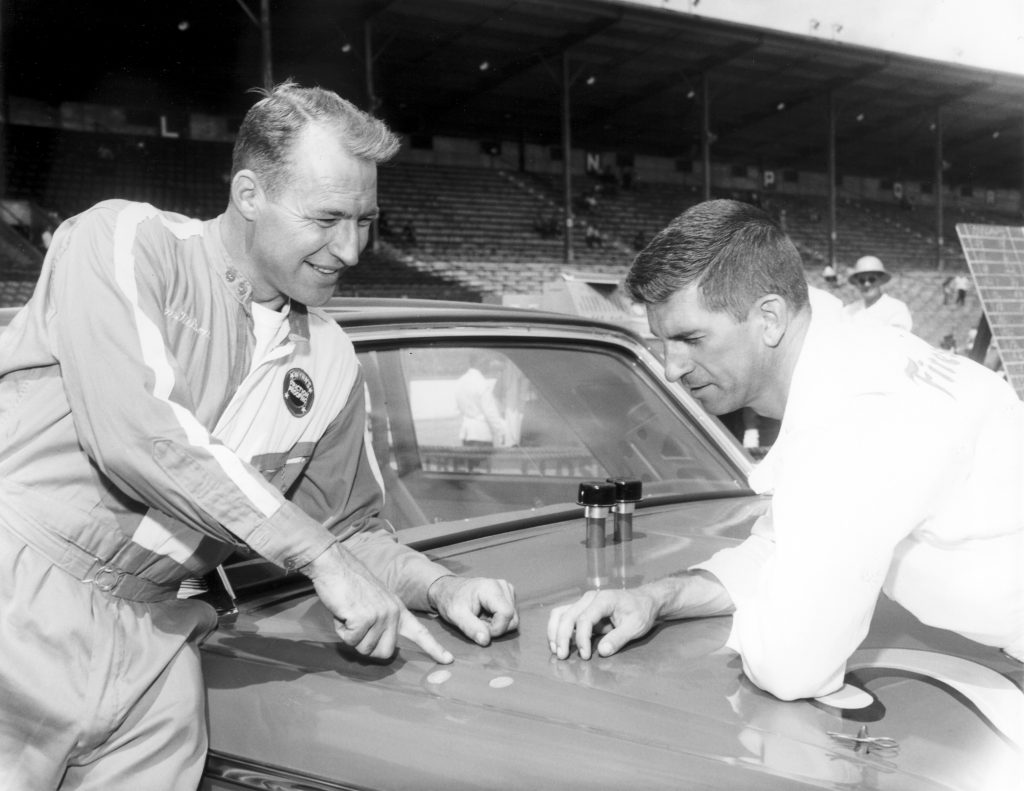
World 600
In the case of the upcoming World 600, Sam McQuagg qualified well in sixth spot. But it appeared that the Nichels crew would have their work cut out for them on race day when qualifying delays relegated Goldsmith and White to 17th and 19th respectively on the starting grid. Goldsmith’s starting spot of 19th was quite extraordinary as he had laid down the fasted pre-race lap of the entire weekend at 149.491 mph.
The results of the race were indicative of the obstacles the Nichels Engineering team were forced to overcome. In the end, McQuagg lost his engine on the 112th lap, finishing 29th. Goldsmith lost his engine after battling a series of near disasters for over 300 laps. First was a broken wheel, then an ignition problem, then his car stalled in the pits and Paul had to be pushed back out on the track. It seemed as if every time Goldy went into the pits he lost another lap. But that didn’t stop him from leading the race for all of 112 laps. In fact, Goldsmith was leading the 400 lap race on lap 301, when his engine finally blew ending his day in 14th place. That left Don White as the final Nichels teammate to run for the green flag. Don in his first race ever on the high banks of Charlotte, brought the No. 31 Nichels Dodge Charger from the 17th starting position to finish third, giving notice to the NASCAR drivers that this USAC Keokuk Komet could indeed “carry the mail.”
With Charlotte finished, one part of the Nichels’ team went north with White on his way to Michigan for the June 3rd race at the Grand Rapids Speedrome. Don quickly made his presence known by capturing the pole and setting a new track record of 23.87 seconds on the one-half mile paved oval in the process. After leading 50 laps, White however began to suffer tire troubles. Norm Nelson then took the lead and never looked back going all the way to the victory. White finished seventh.
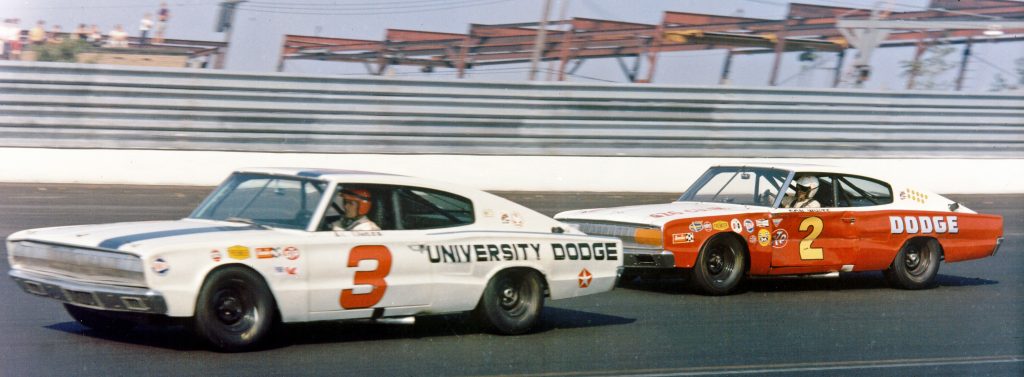
Birth of the rear spoiler
From then on Nichels drivers and crew members along with Chrysler engineering staff spent considerable time testing at Daytona. Their work was primarily with the newly designed Dodge Charger. Since February, the various teams running the new fastback Charger had experienced “lift” in the rear of the cars at high speeds. Reports of the cars becoming so loose that their rear tires were spinning while at speeds of 180 mph came from several unnerved drivers, many of them veterans. As qualifying for the Monday, July 4th running of the Daytona Firecracker 400 drew near, a breakthrough was made. Detailed testing of the Nichels Engineering cars revealed that the placement of a metal strip approximately one and one-half inches high across the trunk lid of the car aerodynamically stabilized the rear of the car tremendously. The strip of metal was contoured to create a sweeping effect, removing the car’s inherit rear-end lift almost immediately. Thus was born the first rear spoiler in NASCAR racing.
As qualifying for the Eighth Annual Firecracker 400 at Daytona got started it became quite clear that the Chrysler contingent was loaded for bear. LeeRoy Yarbrough took the pole at 176.666 mph in his Nichels Engineering-built Jon Thorne Dodge Charger. Of the top ten qualifiers, only one wasn’t a Mopar, that being Curtis Turner in a Smokey Yunick Chevy.
Meanwhile, following Daytona qualifying Don White, Jim Hurtubise, and Mario Andretti flew to Indianapolis to participate in the fourth USAC stock car contest of the year. This time it was the 100 miler on the dirt at the Indiana State Fairgrounds on the evening of Saturday, July 2nd. Don White put his Nichels Charger on the pole and got off to super start. But without warning, Don lost his brakes on lap 20. Most drivers would have called it a night. Not Don White, the diminutive speedster battled his mount for the next 80 laps, holding off the field, save for one, Norm Nelson. White’s sliding his almost 4,000 pound stock car around the historic Indy dirt track for over 80 laps was a testament to his racing skill, strength and stamina. In end, Don held on for a second place finish and most importantly kept pace with defending USAC stock car champion, Norm Nelson’s pursuit of the 1966 championship.
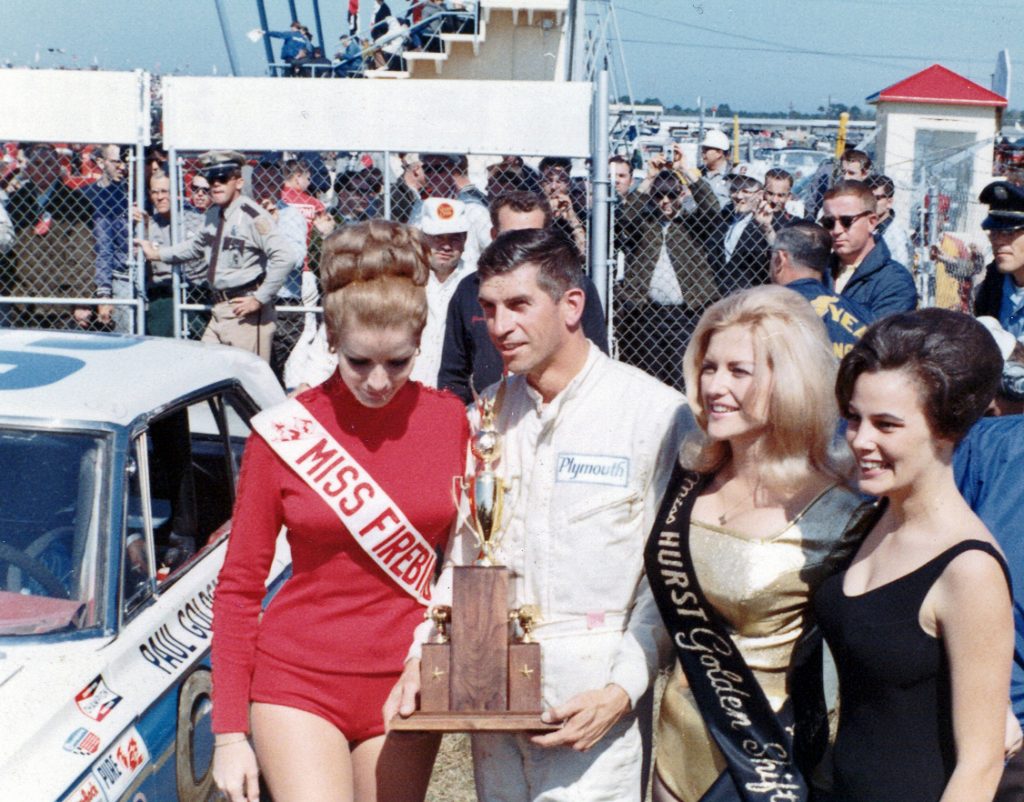
“Backdoor” Hemi
Returning immediately to Daytona, White walked in to a hornet’s nest of circumstance with the Nichels team. On Friday, following qualifying in fourth position, Sam McQuagg blew an engine in practice, his second since arriving at Daytona. Told there weren’t any engines left to install in his Dodge Charger, McQuagg subsequently learned that there was an engine available in a Nichels car hauler, but it reportedly was a back-up for Paul Goldsmith. McQuagg was the youngest and least experienced driver in the Nichels stable. Although Don White had also just joined the Nichels Engineering team in 1966, he had a lengthy history of racing stock cars, winning national championships in both IMCA and USAC. This left McQuagg at the bottom of the pecking order behind Goldsmith and White when it came to priorities. Although thrilled to have a factory ride the quality of one with Nichels Engineering, no one, least of all a truly competitive race car driver like Sam McQuagg wanted to be considered the number three man on a list of three. That being the case, McQuagg went directly to Ronney Householder and asked about the “Goldsmith” engine. Householder quickly ordered Ray Nichels to fly in Minnie Joyce from Indiana and install the subject engine. Unbeknownst to McQuagg, the Hemi that Minnie Joyce installed didn’t belong to Goldsmith; it was earmarked for Don White. One of the advantages of having Don White as part of the Nichels Engineering team, was he took a hands-on approach to all aspects of his cars and engines. He worked closely with Jim Delaney; the Nichels shop manager, along with Cecil Van Horssen, Jerry Govert and Minnie Joyce when it came to suspension and engine issues. Which meant any Nichels Engineering engine earmarked for Don White was a robust powerplant to say the least.
Daytona Firecracker 400
Saturday morning, resulting from his seeking the support of Householder, Sam McQuagg got one hell of a Hemi engine installed by Minnie Joyce. Later that afternoon, McQuagg was lapping the vast Daytona Speedway at an average of 178 mph. As the talk around the track about McQuagg’s speeds was beginning to surface, the 29 year-old driver still wasn’t being given much of a chance to win the upcoming 400 mile race. Many openly speculated that the unrelenting Daytona heat would take its toll on the young driver and he would fail to finish. So taken for granted were McQuagg’s skills that before the race, when the Pure Oil Company Panel of Experts, a group made up of 69 of the top racing writers and broadcasters had cast their votes for their favorite to win this year’s Firecracker 400. Not one listed Sam McQuagg.
On race day, at the drop of the green flag, Sam McQuagg in his No. 98 Nichels Engineering Hemi Dodge Charger wrestled the lead from LeeRoy Yarbrough on the backstretch and ended up leading all but 34 laps on the way to his first NASCAR victory in 31 starts. In the process, McQuagg’s Nichels Engineering Dodge Charger set a Firecracker 400 record of 153.813 mph, breaking the two-year old mark held by A.J. Foyt in his Nichels Engineering Hemi-Dodge Polara. McQuagg beat the Daytona field to the checkered flag by over a minute. It was the first NASCAR victory ever for the Dodge Charger and the first NASCAR victory ever by a stock car utilizing a rear spoiler. Stock car racing’s aero wars had begun. Nichels Engineering had dominated Daytona and Minnie Joyce once again watched one of his Hemi engines destroy the competition in a major American stock car race.
Some Mopar pilots fared well that day and some didn’t. Jim Paschal finished third in his Friedkin Plymouth, while Don White in his Nichels Charger finished sixth and Marvin Panch, driving a second Friedkin, entry came in seventh. Goldsmith lost a windshield, placing 27th and Richard Petty ended up 29th the victim of a crash. The Chrysler corporate marketing effort was at Daytona in force that weekend. Both Goldsmith’s and Petty’s 1966 Plymouths were labeled with the huge letters GTX emblazoned on the side of their cars, advertising the new model name for the upcoming 1967 Plymouth sales season. Lastly, so successful was the Nichels Engineering spoiler that just over a week later, every Dodge dealership in the country, now offered the bolt-on option. As with all Chrysler high performance parts, the part number in the Mopar catalog, started with an “N” denoting that it was a product of Nichels Engineering.
Following their spectacular win in front of a record Firecracker 400 crowd of over 40,000 fans, the Nichels Engineering racing operation seemingly caught fire.
Don White and his Nichels Engineering crew went to the Milwaukee Mile on July 10th, where he took the pole with a new track qualifying record and then won the 200 mile race in dominating fashion. With track temperatures hovering near 120 degrees, Don captured the lead for good on just the 49th lap and drove away from the field in front of almost 25,000 fans. It was the first ever Dodge win in a stock car race at Milwaukee and the second time Nichels Engineering had accomplished such a feat, as they also owned the first ever Pontiac win at “The Mile.” It was Don’s first win at Milwaukee since 1963, moving him from ninth to third in USAC championship points. For good measure, White won the next USAC race at Grand Rapids on July 22nd. Don was now clearly back in the hunt for the USAC season championship, chasing defending champion and Plymouth pilot, Norm Nelson.
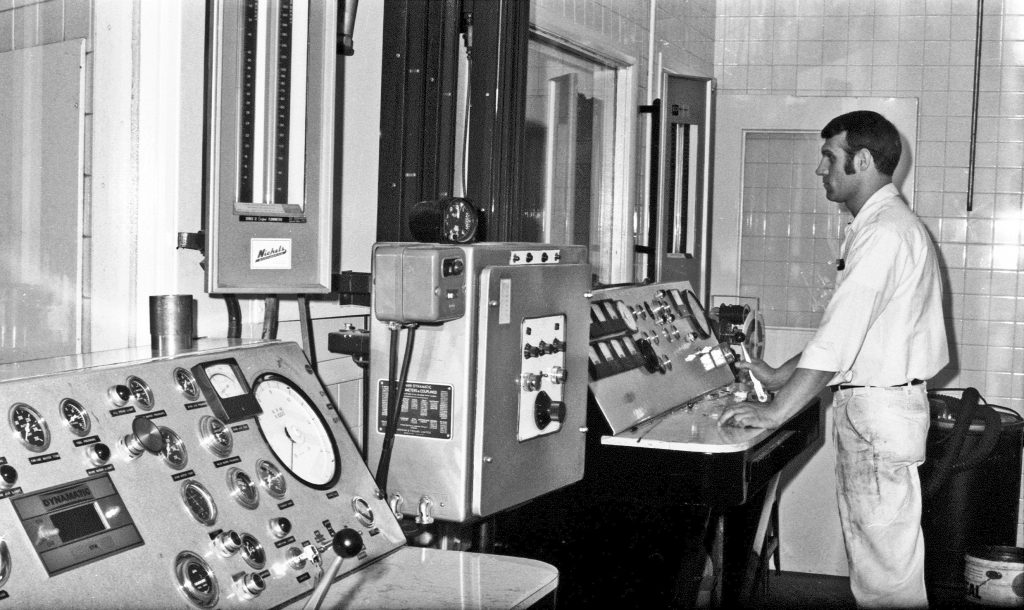
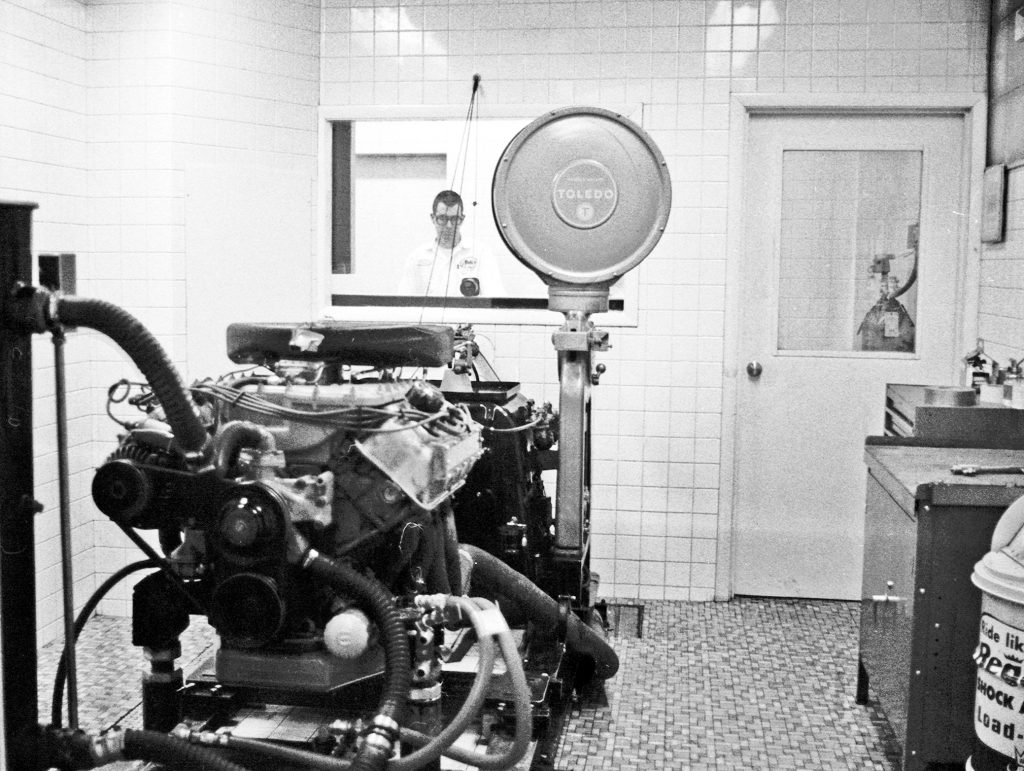
Two weeks later, Paul Goldsmith, not to be outdone by McQuagg and White, proceeded to win the fourth stock car race in a row by Nichels Engineering. Goldsmith systematically stalked the field until the 496th lap to finally pass Richard Petty’s Plymouth (being driven by Jim Paschal) to win the Six Annual Volunteer 500 at Bristol. Paul overcame falling a couple of laps off the pace after running out of gas, by relentlessly working his way back through the field on the one-half mile track. By the time he caught Paschal, both Mopar pilots proceeded to run side-by-side for several laps, bringing the 18,000 fans to their feet. Following the stirring victory, Goldy’s third of the 1966 season, Stock Car Racing magazine writer Jim Hunter wrote: “The coolest thing about Paul Goldsmith is his nerve; it’s about the same as the color of his car: ice blue.”
The Andretti flip
Nichels Engineering seemingly unstoppable at this point, headed to their next USAC challenge, the Saturday, July 30th event at Canada’s racing hotspot, Mosport Park. For this race, Nichels took on a new driver to run alongside Don White. Joining the Nichels stable for this contest was rising young racing star and USAC defending Indy car champion, Mario Andretti. Nichels Engineering provided both White and Andretti with identical Hemi-powered Dodge Chargers. The 2.459 mile road course, with alternating uphill and downhill runs, was a unique challenge for any driver. It was with that in mind, that before Friday’s practice, Ray Nichels asked the young Andretti to go out on the track (in the No. 31 Nichels Charger) behind the seasoned veteran White (in the No. 3 Nichels Charger), and follow Don for some practice laps. White had raced stock cars at this venue before and knew the hazards hidden in this unique racing venue. Nichels reasoned that Andretti could see White’s preferred line through the course and get used to idiosyncrasies of the heavy-bodied Dodge Charger. Sending both drivers out onto the track, Nichels’ crew waited to see the Dodges perform before making the final setups for qualifying later in the day. After only a couple of laps, Andretti, supremely confident in his ability, decided to pull away from the stock car veteran White. On the third practice lap, Mario promptly flipped the Nichels Charger four times, damaging just about every major component on the car from the roof to the suspension. Over the next six hours, the Nichels crew performed a Herculean task putting the Andretti mount back in racing trim, barely in time for qualifying.
White whose Nichels crew was now at the top of their game took pole position for the first heat. As with earlier USAC contests the competition was keen as ever. In the first heat, White clearly proved to be the fastest car on the track in the 50 lapper. But that didn’t stop Norm Nelson and Mario Andretti from pushing White hard during the early laps of the race. In the end though White finished with a comfortable 30 second lead, telling his crew that he made every effort not to abuse his Dodge late in the race, saving his car for the second 125 mile heat. And it looked as if Don’s logic would capture him the overall race victory. However, on the 46th lap of the second heat, White’s strategy came apart, just as quickly has his Hemi engine, when he broke his crankshaft in half. White’s DNF appeared to enable Nelson, Andretti and Canada’s own Billy Foster to battle for the victory. Andretti charged into the lead, only to suffer a broken sway bar finishing his day. Unbelievably, Billy Foster’s ignition then gave way finishing his effort. Then, seemingly coming out of nowhere, with just over a lap remaining, Chicago’s own Salvatore “Sal” Tovella raced into the lead capturing the checkered flag. By virtue of his fourth place finish in the first heat, Tovella, in his 1965 Plymouth, was named the overall winner of the Kawartha 250, his first victory in USAC competition and clearly his biggest day ever in his stock car racing career.
With the racing season in high gear, Chrysler Corporation was dominating the nation’s stock car tracks. By the start of August, Norm Nelson was leading the USAC season points chase and David Pearson, driving Dodges for Cotton Owens had already won 11 times in 31 starts, and was leading the NASCAR season title hunt. But battles between the automakers, sanctioning bodies and even the NASCAR and USAC inspectors, made for race car chaos.
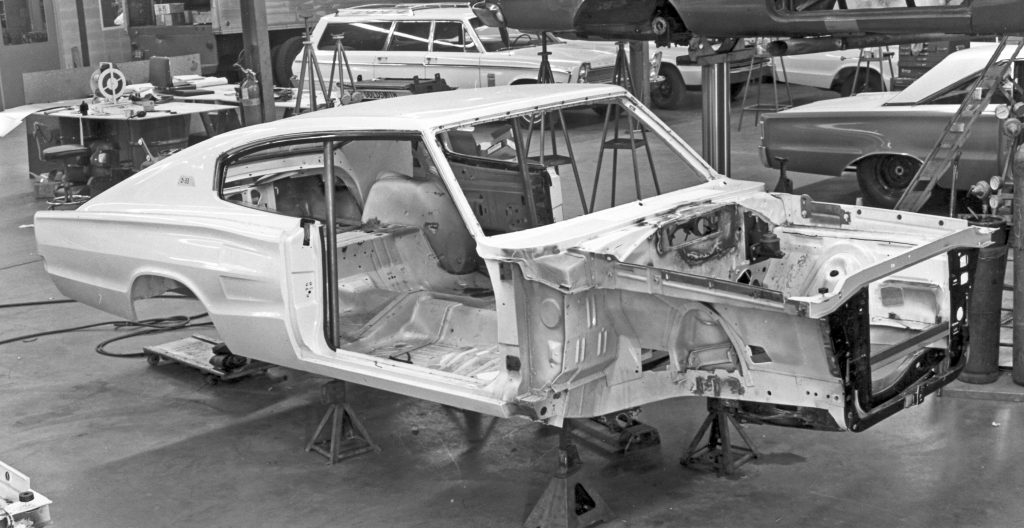
NASCAR bends the rules
What happened next during the race weekend of August 7th’s Dixie 400, made things appear even worse. The arrival of Junior Johnson’s entry, a bright yellow Ford Galaxie to the Atlanta track was the catalyst for controversy. Johnson’s entry was by no means a normal Ford Galaxie. For openers, Junior had completely restructured the roof of the car. It was apparent that the roof had been cut away, then substantial sections of the roof’s posts were removed and the roof welded back on. In fact, the car’s roof line was reduced in height so much, that driver Fred Lorenzen had to lower his seat in order to see out of the newly sloped windshield. The front fenders of the car seemed to almost engulf the tires and the rear of the car was jacked up higher than any other car in the paddock. Its odd shape seemed to scream out for a nickname. It got one in a hurry, the “Yellow Banana.” Not to be outdone, Smokey Yunick showed up with a black and gold Chevrolet Chevelle that had also undergone some sort of assembly metamorphosis, with the wheels off-center of the car-body’s cutaways, a handcrafted front end and a spoiler built into the roofline.
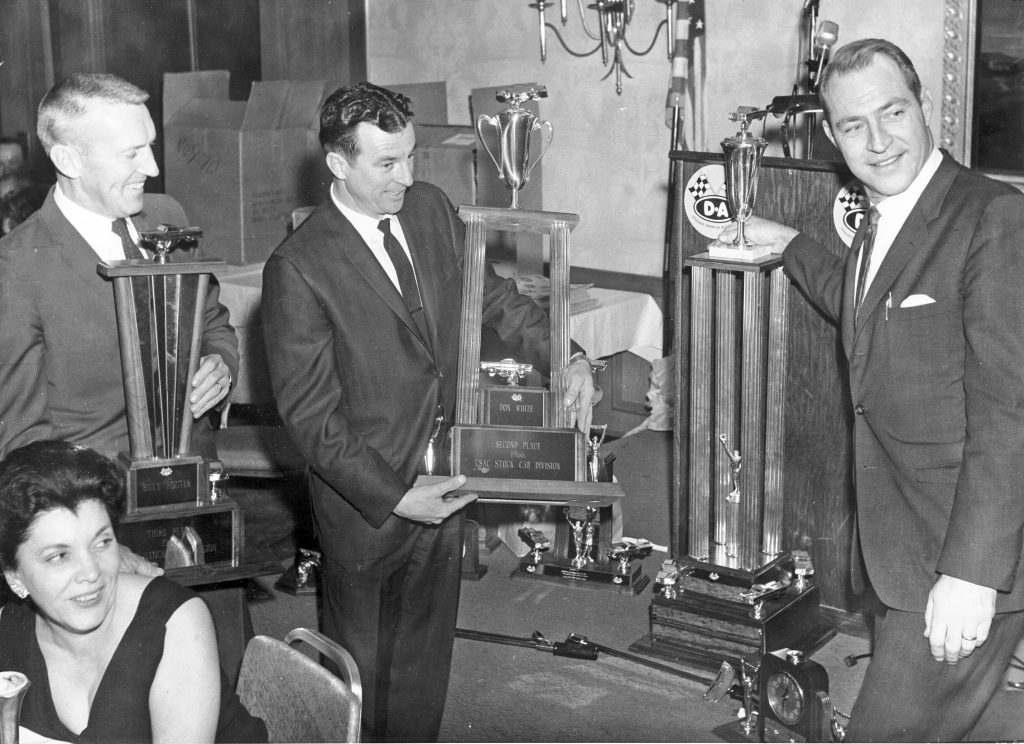
To the amazement and subsequent anger of the other competitors, both the Johnson Ford and the Yunick Chevy passed NASCAR inspection. The cries of “unfair” could be heard all the way to NASCAR headquarters in Daytona Beach. In the meantime, Cotton Owens’ Dodge was found to have a device that allowed Pearson to lower the front end of his car after the race had started. Owens in a defiant stand against what he believed to be different rules for different race competitors, refused to alter his No. 6 Dodge Charger, as long as Johnson’s and Yunick’s cars were left as is. When told that NASCAR demanded Owens car be “brought up to NASCAR standards” Cotton loaded up his Dodge and left Atlanta in a staggering display of defiance by a team in the hunt for the NASCAR season national championship.

